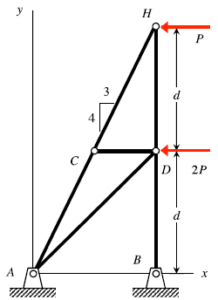Problem statements
Solution video - H21.A
Solution video - H21.B
DISCUSSION THREAD

Please post questions here on the homework, and take time to answer questions posted by others. You can learn both ways.
Problem statements
Solution video - H21.A
Solution video - H21.B
DISCUSSION THREAD

You must be logged in to post a comment.
When I was solving for the loads carried by each truss, I initially tried solving for the reaction forces of pin joints A and B since that's what was done in the example and quiz problems. After checking with the TA, I found that solving for the reaction forces isn't necessary in this problem since the load forces can be calculated independently and finding the reaction isn't required.
Even though the forces can be calculated independently, it still is possible to solve for the reactions first. I assumed that the slope of the member from A to C was the same as the slope from C to H, which allowed me to get the distance between A and B and use a moment equation to solve for By.
If I'm understanding correctly, would this mean the horizontal distance between A and B is 4?
I do not believe that the actual distance matters it just has to do with the relationship according to the angle of the support.
Do you not need the reactions? I don't understand that.
I solved the equations for Fx and Fy first at point H because there were only 2 unknowns. This allows you to solve for the unknowns, and those unknowns become known forces for other joints. After H, I was able to solve at C and then D. These gave me the forces for all truss members without having to solve at points A or B, meaning I didn't need to know the reactions at all.
I am confused on how to go about solving this problem. I initially used moment equations to solve for the reactions in the y, and then began solving for loads carried at trusses using these values. That being said, I started getting conflicting answers, for example that By was both equal to zero by the individual member equations but also had a value from the moment equations. What is the solving process of this question?
So I started by drawing FBDs for each triangle and making equilibrium equations for Fx and Fy of points D, and H. Then, I rearranged the equations and plugged in the given forces to solve for each member's load.
When I solved for the load on each arm, I got results in terms of both P and d. Is this accepted or should d cancel out somewhere?
I only got answers in terms of P. I don't think d should be in any of them. I used d when finding the angle alpha though. Alpha being the angle between points ADB.
When solving at joint C, I keep getting that the force CD is 0. This doesn't make sense to me when I look at the problem, but I see how it works mathematically. Is this a correct assumption?
This is the right assumption. As mentioned in class, in 2D analysis of trusses, there will be some zero force members that exist. This is due to the fact it doesn't carry any force under the specific loading conditions. These members are typically included in a truss to maintain structural stability and provide support under different loading scenarios.
Are we able to assume that AB is a distance of d as well, where AD would have the distance of d * sqrt(2) for an angle of 45 degrees?
I don't think so, since we are given the slope of the left members (at CH), which can be used to find the length of AB. I recommend drawing out the truss accurately with the slope.
Breaking this problem down into smaller free body diagrams really helped me understand how do get rid of unknowns with Neuton's Third Law of reaction forces. What I did was I analyzed each joint's applied forces, while making sure to account for reaction forces at the fixed joints.
I'm a little confused on how to solve this - after using the method of sections to split the small triangle on top from the bottom three forces, how do you find the angles between BAD?